Best Trees for Shohin Bonsai: Small wonders with big style. The word “Shohin” means “small goods” in Japanese, and these trees are usually no more than 10 inches (25 cm) tall or wide.
Shohin bonsai can be made from various species of trees, such as maples, azaleas, junipers, or pines, but they all share the same challenge of maintaining their health and beauty in a small pot with limited soil and water.
A trunk can be collected and foliage grafted down low, even one branch only in some cases, to create a shohin tree.
Here in the Northeast of the US, as well as Canada, the best material for yamadori Bonsai is the American larch (Larix laricina). It is a great candidate for Bonsai and shohin Bonsai.
You may love the dream of growing a shohin bonsai, but finding the best trees for shohin bonsai can feel like a puzzle. Not every bonsai plant can shrink into a mini bonsai, a mame bonsai display, or even the smallest bonsai without losing its charm.
Some dwarf trees, like a shohin juniper bonsai or a rugged black pine bonsai, give you that strong, classic look. Others, like a willow leaf ficus bonsai, or a bright flowering cherry, bring color and life into your room.
You might even try yamadori bonsai, trees collected from nature, or go online to buy the best trees for shohin bonsai under $100.
Every grower has a choice, and maybe you want a fruit bonsai like crabapple or pomegranate, a steady evergreen like boxwood or olive, or even an ornamental maple that glows red in fall.
No matter if you live in Zone 5, Zone 7, Zone 8, or Zone 10, there is a perfect fit waiting for you.
This guide will show you the small bonsai species that thrive, explain why they work, and help you pick the right one so your little tree feels like a big piece of nature’s art.
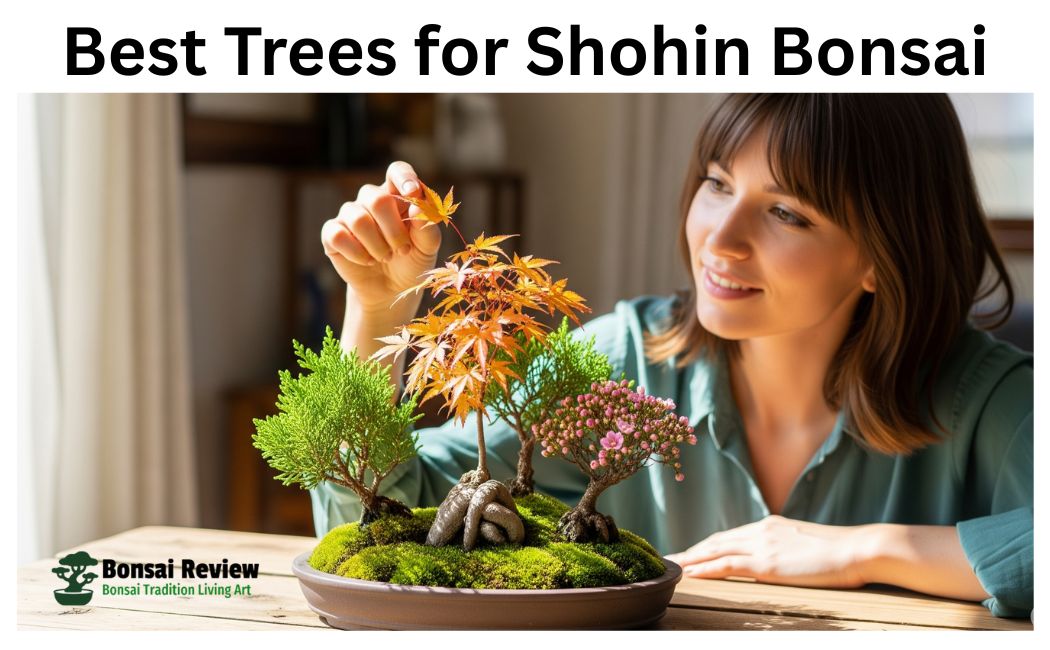
What Makes a Good Tree for Shohin Bonsai?
When you look for the best trees for shohin bonsai, size is only one part of the story. A good shohin bonsai tree must have traits that let it stay small, strong, and beautiful.
- Leaf Size: Small leaves, like those on a willow leaf ficus bonsai or cotoneaster, keep the tree in balance. If the leaves are too big, the tree looks out of scale.
- Branching Pattern: Fine, flexible branches let you shape your tree into styles like informal upright, cascade, or even a miniature mame bonsai display.
- Trunk Character: A strong trunk with taper, like on a shohin juniper bonsai or black pine bonsai, makes the tree look old and powerful, even in tiny form.
- Adaptability: Some species, like olive and boxwood, can handle pruning, repotting, and wiring without stress.
- Seasonal Interest: Flowering and fruiting trees, such as pomegranate, crabapple, or flowering cherry, give you blossoms or fruit that add charm, even in a 6-inch bonsai pot.
Not all trees will thrive in your area. That’s why knowing your USDA Zone (Zone 5, Zone 7, Zone 8, Zone 10) matters. For example, Japanese maples love cooler zones, while tropical bonsai plants like ficus need warmth.
When you match these traits with your climate and care level, you’ll have the right tree that grows well and still keeps its mini bonsai scale.
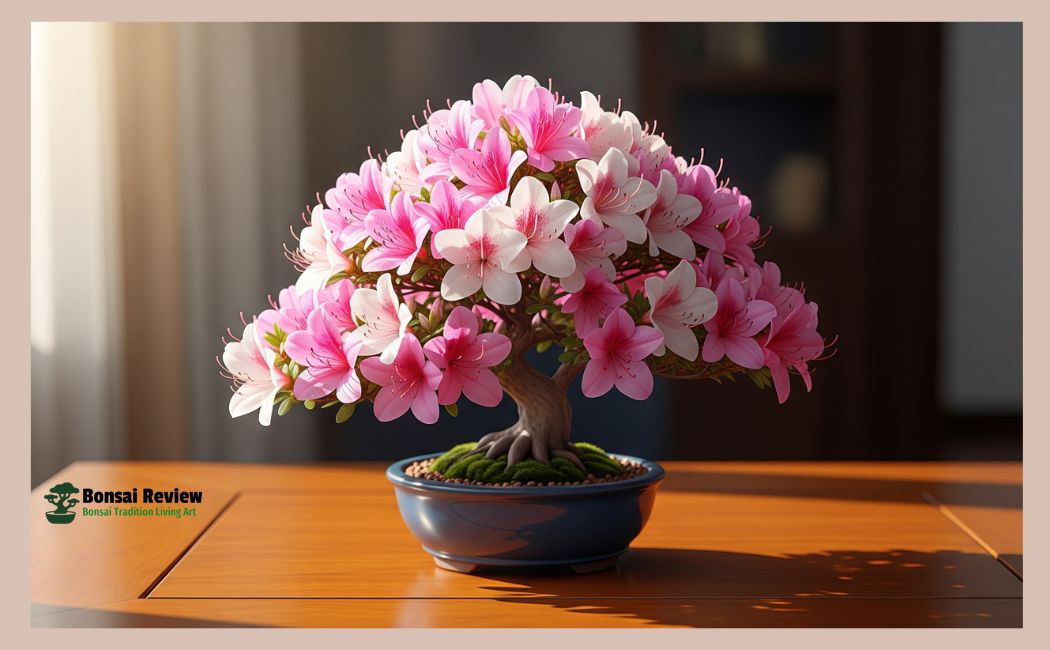
Which Evergreen Bonsai Thrives in Small Shohin Pots?
Best tree species for shohin bonsai. Now that you know what traits make a tree right for shohin bonsai, let’s look at the top species. These are the trees experts love because they keep their beauty even in 6–8 inch bonsai pots.
1. Conifers for Shohin Bonsai:
- Shohin Juniper Bonsai: Hardy, flexible, and great for styles like cascade or informal upright.
- Black Pine Bonsai: Famous in Japanese bonsai exhibitions, strong trunk and rich needles.
- Shimpaku Juniper: Compact foliage, easy to wire, great for beginners.
Best Trees for Shohin Bonsai: Zones 5–9, people who like evergreen strength and a classic bonsai look.
2. Deciduous Trees for Shohin Bonsai:
- Japanese Maple: Stunning seasonal color, fine branching, thrives in cooler zones.
- Trident Maple: Faster growth, small leaves, strong root flare for nebari display.
- Zelkova (Japanese Elm): Elegant silhouette, responds well to pruning.
Best Trees for Shohin Bonsai: Zones 5–7, people who love fall color and refined branching.
3. Tropical & Subtropical Bonsai;
- Willow Leaf Ficus Bonsai: Tiny leaves, strong adaptability, thrives indoors.
- Boxwood: Slow-growing, compact foliage, stays neat even with heavy pruning.
- Olive Bonsai: Drought-tolerant, ancient bark texture, perfect for warm climates.
Best Trees for Shohin Bonsai: Zones 8–10 or indoor growers in colder regions.
4. Flowering & Fruiting Shohin Bonsai;
- Pomegranate: Striking flowers and small fruit that shine in tiny pots.
- Crabapple Bonsai: Mini apples in autumn, seasonal interest all year.
- Flowering Cherry: Blossoms bring spring beauty in miniature form.
Best Trees for Shohin Bonsai: Growers who love seasonal flowers and fruit, even in mini bonsai display stands.
These species give you a balance of small leaf size, good branching, and lasting beauty. The choice depends on whether you want evergreen strength, fiery autumn colors, tropical resilience, or blossoms and fruit.
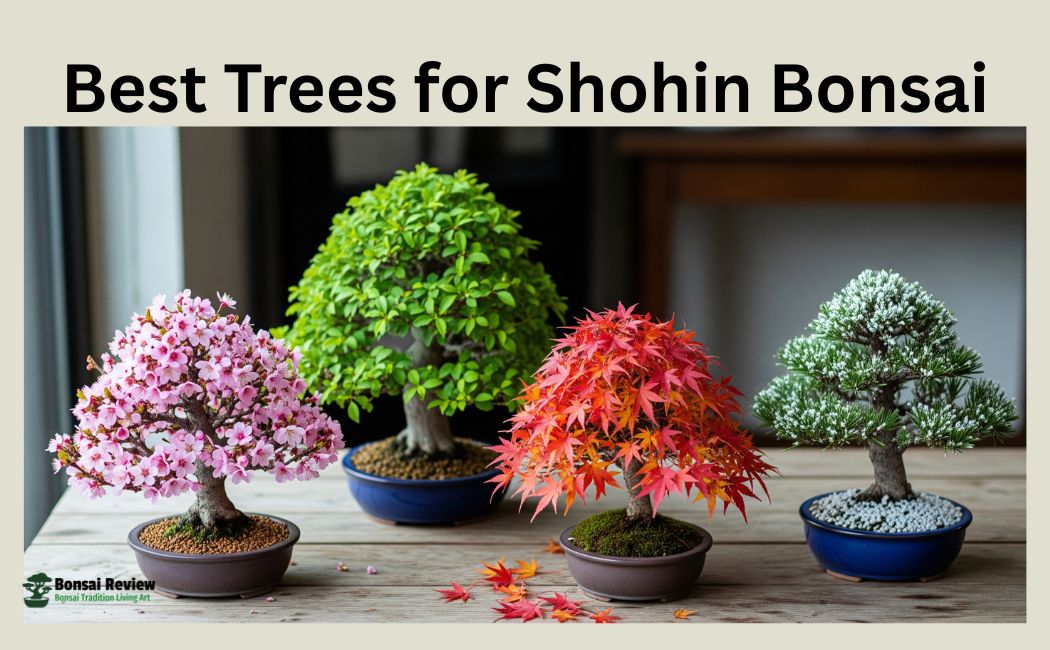
How to Choose the Best Shohin Bonsai: Evergreen, Flowering & Fruit Options?
Best Shohin Bonsai Tree Types Quick Guide, Shohin bonsai are a type of bonsai that are small enough to be held in one hand. Shohin bonsai require frequent watering, fertilizing, pruning, and repotting to keep their roots healthy and their shape balanced.
| Shohin Bonsai Type | Key Features | Best Zones | Why Choose It? |
| Juniper Shohin Bonsai | Evergreen, hardy, forgiving | Zone 5–6 | Classic style, easy to train, very popular |
| Ficus Bonsai (Willow Leaf, etc.) | Tropical, thrives indoors, fast grower | Zone 10 | Great for warm homes, flexible styling |
| Maple Shohin Bonsai | Seasonal color, delicate leaves | Zone 7–8 | Beautiful autumn shades, good for display |
| Black Pine Bonsai | Strong needles, bold trunk | Zone 6–9 | Traditional bonsai look, long lifespan |
| White Pine Bonsai | Softer, refined foliage | Zone 6–8 | Elegant, ideal for collectors |
| Flowering Shohin Bonsai (Azalea, Cherry, etc.) | Bright blooms, seasonal charm | Zone 6–9 | Adds color, loved by hobbyists |
| Fruit Shohin Bonsai (Crabapple, etc.) | Tiny fruits, playful style | Zone 6–8 | Unique, brings joy to displays |
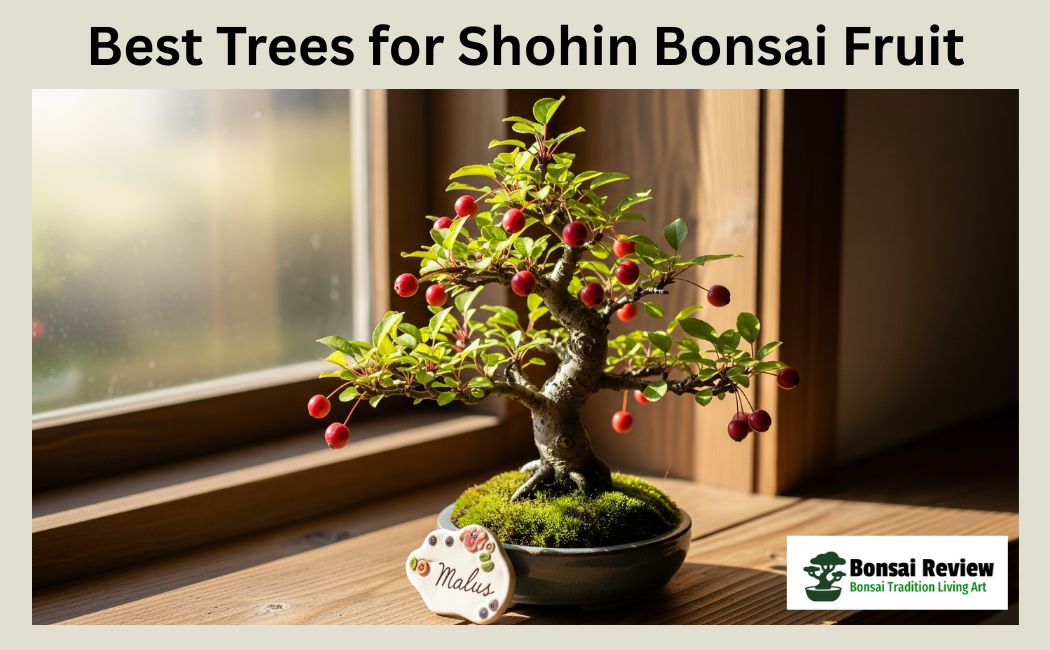
You can even find Shohin bonsai under $100 online or in nearby stores. Whether you’re into evergreen Shohin bonsai, flowering Shohin bonsai, or the smallest bonsai like mame bonsai, there’s always a perfect match for your collection.
Buying Guide: Where to Find the Best Trees for Shohin Bonsai?
Finding your perfect shohin bonsai is easier when you know where to look. Here’s how to make the right choice:
1. Local Bonsai Nurseries & Clubs;
- Visit local nurseries or bonsai clubs to see trees in person.
- Ask about the juniper best trees for shohin bonsai or evergreen shohin bonsai.
- Great for inspecting the trunk, leaves, and overall health before buying.
2. Online Bonsai Shops;
- Many sellers ship mini bonsai and mame bonsai display trees nationwide.
- You can search for buy best trees for shohin bonsai under $100 or the best trees for shohin bonsai sale.
- Popular options include Ficus bonsai, black pine bonsai, and flowering bonsai.
3. Climate & Zone Considerations
Make sure the tree fits your USDA zone:
- Zone 5 for hardy maples, elms, junipers
- Zone 7–8 for pines, flowering cherry, crabapple
- Zone 10 for tropical species like Willow leaf ficus bonsai or olive bonsai
This ensures your mini bonsai survives and thrives year-round.
4. Budget-Friendly Options;
- You don’t need a big budget to start. Many small bonsai or shohin bonsai under $100 are available online.
- Look for yamadori bonsai if you want unique, wild-collected trees. Check legal sourcing rules.
Best Trees for Shohin Bonsai Tip: If you’re looking for a nearby bonsai store or buying online, always check the tree’s health, root structure, and pot size. The right tree today becomes a cherished mame bonsai display tomorrow.

Care Challenges & Tips: Best Trees for Shohin Bonsai.
Growing a shohin bonsai is rewarding, but these tiny trees have unique needs. Even a mini bonsai or the smallest bonsai can thrive if you follow these tips:
1. Watering;
- Small pots dry out faster, so check daily, especially for juniper and black pine bonsai.
- Ficus bonsai prefers consistent moisture but never waterlogged soil.
2. Pruning & Shaping
- Keep leaves small and branches balanced.
- Use mame bonsai display techniques to maintain proportional growth.
- Flowering and fruiting trees like crabapple or azalea need careful pruning to encourage blooms.
3. Repotting
- Mini bonsai and shohin bonsai require repotting more often than larger bonsai.
- Check roots yearly and refresh soil to prevent crowding.
4. Light & Temperature
- Evergreen shohin bonsai, like boxwood and olive, need sunlight, but indoor Ficus bonsai thrive in bright, filtered light.
- Consider your USDA zone when placing outside: zone 5 trees may need frost protection, while zone 10 species enjoy warm indoor spots.
5. Fertilizing & Health
- Feed small bonsai lightly but regularly.
- Flowering and fruiting trees benefit from bloom‑encouraging fertilizers.
- Watch for pests and adjust care for sensitive species like willow leaf ficus bonsai.
Tip: Even the smallest bonsai can carry big character if you balance watering, pruning, and sunlight carefully. A well-maintained mame bonsai display will stay healthy and beautiful year-round.

What are the Best Styling & Display Ideas for Shohin Bonsai?
Your shohin bonsai can be a tiny masterpiece when displayed correctly. Even the smallest bonsai can steal the spotlight if you plan its style and presentation.
1. Mame Bonsai Display
- Group several mini bonsai together to create a miniature forest effect.
- Mix evergreen best trees for shohin bonsai, like juniper, with flowering or fruit bonsai, such as azalea or crabapple.
- Use different pot shapes and heights to add visual interest.
2. Single Feature Display
- Highlight a shohin juniper bonsai or black pine bonsai on a pedestal.
- A simple, uncluttered setting draws attention to the tree’s trunk and branch character.
3. Seasonal Arrangements
Swap trees based on season:
- Maple bonsai for fiery autumn color
- Flowering cherry or azalea for spring blossoms
- Evergreen bonsai for winter greenery
Use small stones or moss to complement the scene.
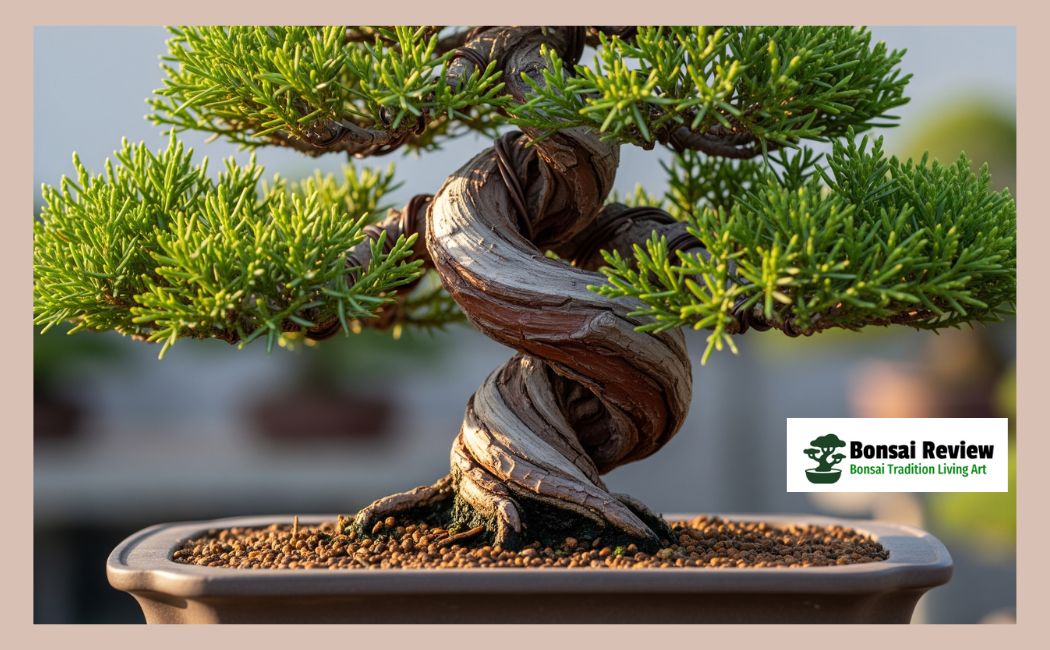
4. Indoor vs. Outdoor Display: Best Trees for Shohin Bonsai
- Indoor spaces: Willow leaf ficus bonsai, small ficus bonsai, or dwarf bonsai species thrive in filtered light.
- Outdoor spaces: Black pine, juniper, and flowering bonsai enjoy full sun.
5. Creative Containers & Styling
- Experiment with unusual pots, shallow trays, or paired arrangements.
- A mame bonsai display with a mix of evergreen, flowering, and fruiting shohin bonsai creates a living art piece.
Best Trees for Shohin Bonsai Tip: Even the tiniest tree can feel like a big natural scene when styled carefully. Remember to consider:
- Size & leaf scale: keep your mini bonsai in balance.
- Climate zone: ensures your tree thrives in zone 5, zone 7, zone 8, or zone 10.
- Indoor vs. outdoor growth: Choose Willow leaf ficus bonsai or tropical species for indoor warmth.
- Budget & availability: look for buy best trees for shohin bonsai under $100 (Approx.) online or at local nurseries.
Combining mini bonsai of different types and colors gives your space charm and balance.
Conclusion: Finding Your Perfect Shohin Bonsai
Growing a shohin bonsai may seem challenging at first, but with the right tree and care, even the smallest bonsai can bring big joy.
From juniper, black pine, and shohin juniper bonsai to flowering bonsai like azalea and fruit bonsai like crabapple, there’s a perfect tree for every taste, space, and climate.
With proper watering, pruning, and repotting, your mame bonsai display or single tree can stay healthy and beautiful for years.
Shohin bonsai are admired for their delicate and refined appearance, as well as their ability to depict the essence of nature in miniature form.
Start with forgiving species, explore styling options, and enjoy the art of these miniature trees. They may be small, but they carry a lifetime of nature’s beauty.
Helpful article: Which Ones Are Good Bonsai Trees For Indoors? Are They Really Pet-Safe And Low-Light Plants?
FAQs: What Makes a Shohin Bonsai Different from Other Mini Bonsai?
1. What is a Shohin Bonsai?
A shohin bonsai is a small bonsai, usually under 20 cm tall. It can be part of a mame bonsai display or stand alone as a mini bonsai, perfect for small spaces.
2. Which Trees Are Best for Shohin Bonsai?
Some best trees for shohin bonsai choices include traditional pots:
1. Evergreens: Juniper, Black Pine, Boxwood, Olive
2. Deciduous: Japanese Maple, Trident Maple, Zelkova
3. Flowering & Fruit: Azalea, Cherry, Crabapple, Pomegranate
4. Tropical/Indoor best for Shohin Bonsai: Willow Leaf Ficus, Dwarf Ficus.
3. Can I Buy Shohin Bonsai Online or Nearby?
Yes! Many sellers offer buy best trees for shohin bonsai, including options under $100. Check local bonsai nurseries or online stores for mini bonsai, evergreen, flowering, or fruiting bonsai.
4. How Often Do Shohin Bonsai Need Watering?
Because small bonsai pots dry quickly, water daily or when soil feels dry. Juniper and Black Pine bonsai need careful attention to avoid over- or under-watering.
5. Are Flowering and Fruit Bonsai Harder to Care For?
They can be slightly more demanding. Crabapple, azalea, and pomegranate bonsai need proper pruning, sunlight, and fertilizing to bloom and fruit well.
6. Which Zones Are Best for Shohin Bonsai?
1. Zone 5–6: Juniper, Japanese Maple, Trident Maple
2. Zone 7–8: Black Pine, Flowering Cherry, Crabapple
3. Zone 10: Tropical species like Willow Leaf Ficus Bonsai or Olive
7. Can I Create a Mame Bonsai Display?
Yes! Combine mini bonsai of different types, evergreen, flowering, and fruiting, to make a small yet striking mame bonsai display.